
Call us today at +321 123 456 7
or email us at info@example.com
If you seek truth you will not seek victory by dishonorable means,
and if you find truth you will become invincible.
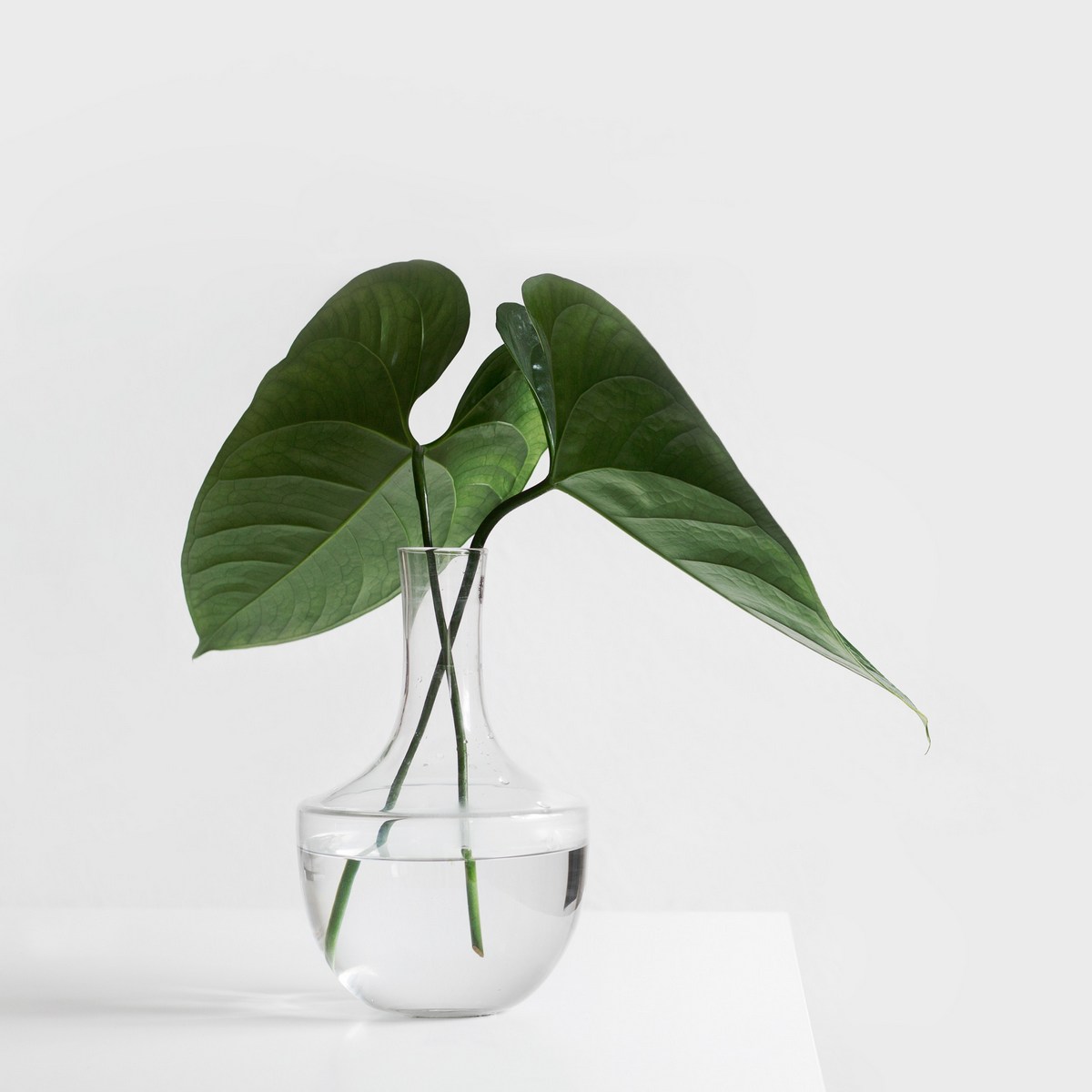
If you seek truth you will not seek victory by dishonorable means,
and if you find truth you will become invincible.

Trip to: Osogbo
Date: 19-20 July 2008
Trip leader: Paulette van Trier
On Saturday 19 June 2008, over a dozen NFS members waited eagerly at EKO hotel for the departure to Osogbo.
Luckily the third mainland bridge maintenance work was postponed to August but we still spent a little over four hours to arrive at Osogbo. Our first stop was at Nike’s Guest House, where we checked into our respective rooms and had our lunch break after the long journey. Whilst the Guest House accommodation is quite basic, it has a beautiful garden where you can enjoy your breakfast under the sun and enjoy a nice stroll, a luxury that denies us in busy cosmopolitan Lagos.
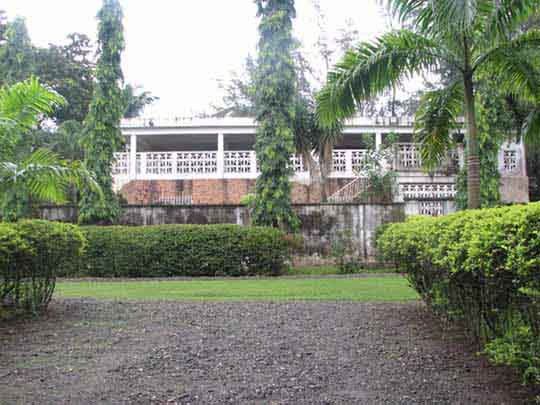
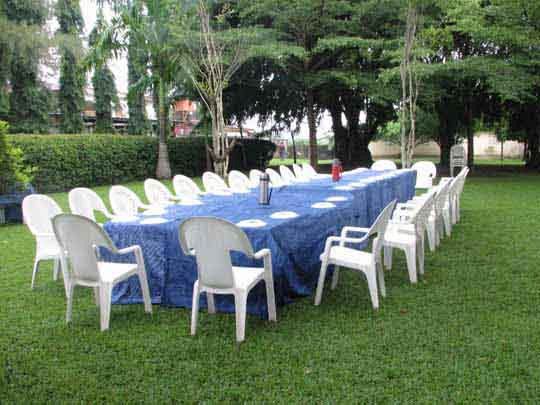
Osogbo is the capital city of Osun State and is famous in arts and sculptures. Situated on the outskirts of Osogbo town lies the infamous Sacred Groves of Osogbo, a vast area of unspoilt nature serving as a sanctuary for the Orisha – the Yoruba gods in the traditional concept. The groves in Osogbo are the home of Oshun – the goddess of “the waters of life as well as the abode of the goddess of fertility Oshun, one of the pantheons of Yoruba gods.
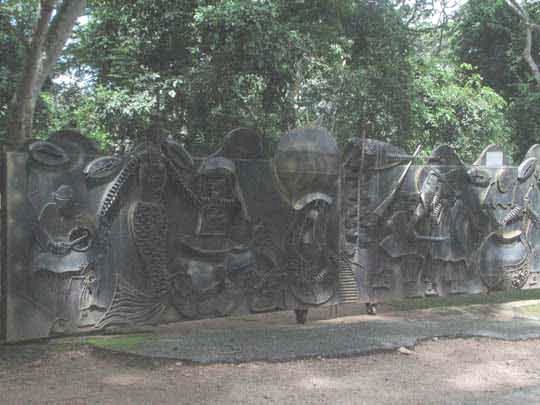
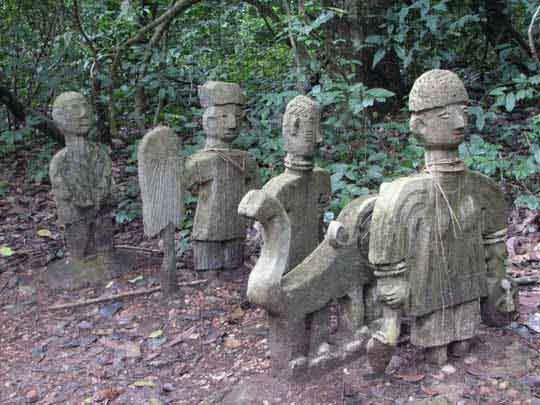
We joined a 2-hour guided walk in the groves that gave us an interesting perspective into the culture and religion of Yoruba people. The landscape of the grove and its meandering river is dotted with sanctuaries and shrines, sculptures and art works in honour of Osun and other deities.
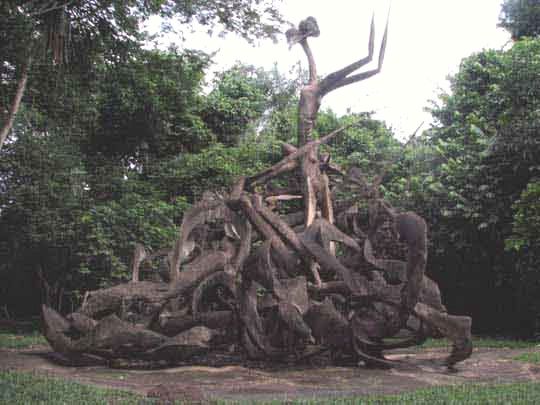
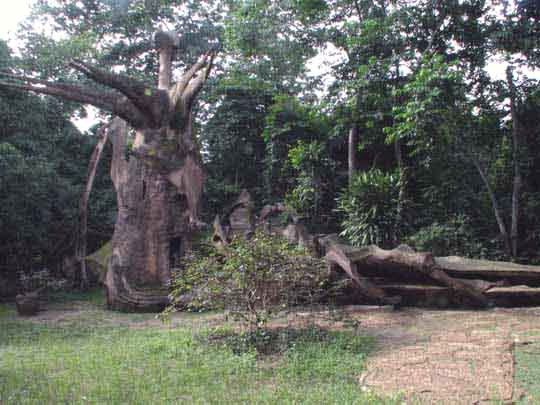
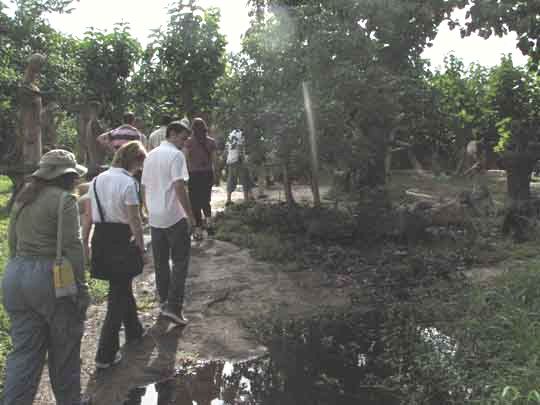
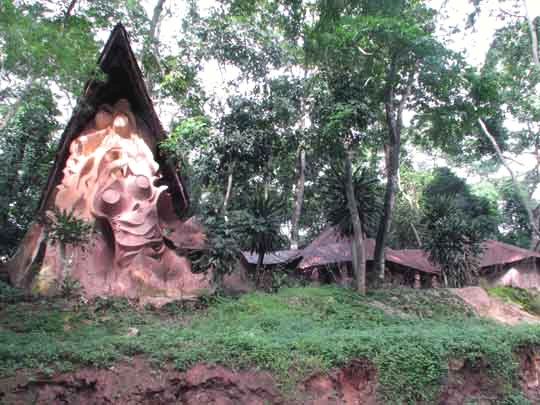
We were also very surprised to find many beautiful, enigmatic and enormous sculptures that are well preserved in the groves. It is here that we were introduced to the amazing conservation efforts of Suzanne Wenger and her iconic work of art that has integrated with nature, now protecting it. These sculptures, some to the height of a four-storey building represented Suzanne’s effort to immortalize and celebrate the Gods of Orisha. We completed our tour at Suzanne’s first home in the Sacred Groves.
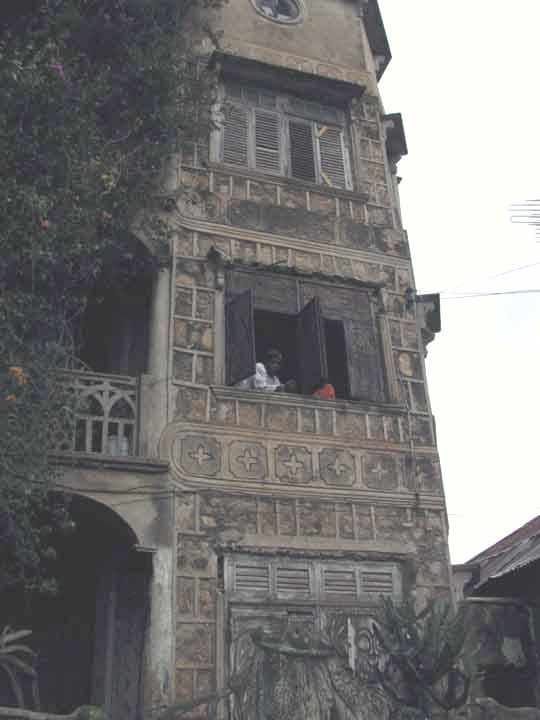
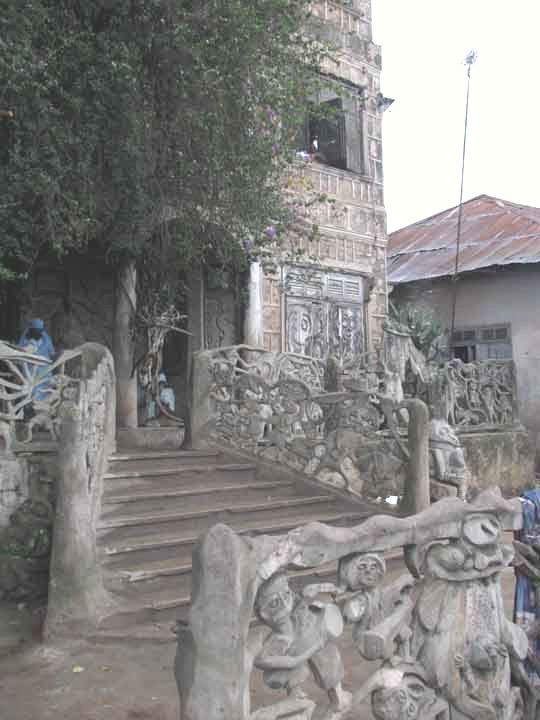
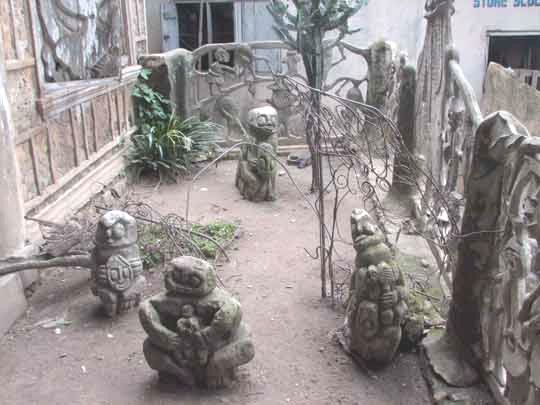
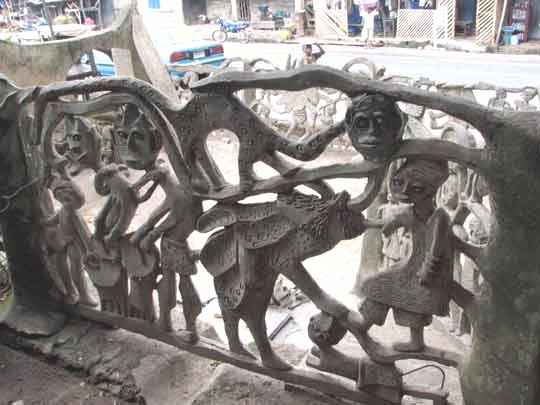
Our next stop was at Suzanne’s existing abode, situated in the town of Osogbo itself. It is a very artistic and gorgeous place. The house is distinctly different from other buildings in the vicinity. The fence, door, staircase, and pillars are all intricately carved with sculptures that set it apart from the mundane brick and clay buildings of its neighbours. Downstairs we saw many jovial children apparently being tutored in the subject of arts in the In her room upstairs, metal-works, sculptures of wood and of stone, house too. and paintings clustered in the middle calling out for attention in an otherwise dimly lit room.
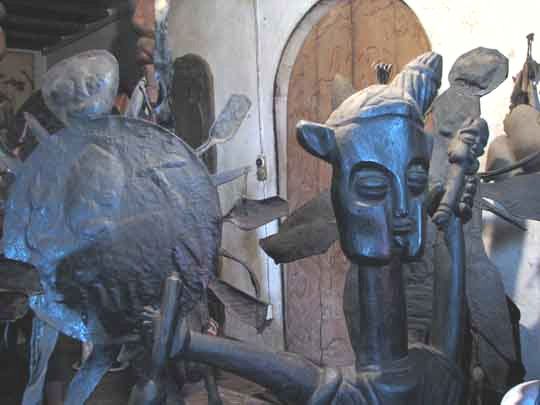
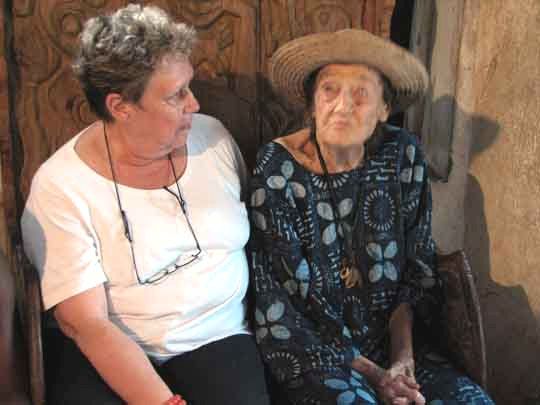
To many in Osogbo, Suzanne is affectionately called “Mama”. She is bestowed the title of Adunni (adored one) for dedicating almost all her life (since 1950s) to preserving the shrine and in the process creating a national landmark in Nigeria – Sacred Groves of Osogbo, now a UNESCO World Heritage site. At 93, she still looks healthy in her Adire outfit and kindly entertained our many questions. Her simple answer to the question about “which piece of sculpture in the groves is her favourite” struck me on how closely her life is intertwined with the rites and culture of Orisha – she replied: “How do you choose between the Gods?”
On the way back, we stopped at Nike Art Gallery. A 2-storey building inside which displays the work of Nike and her students. Nike was still stuck in the traffic in Ibadan so our tour of the workshop had to wait till the next day.
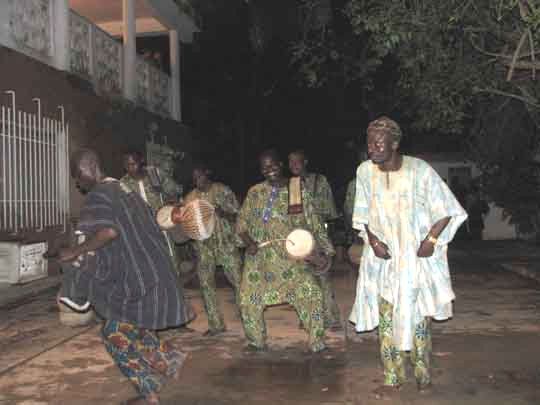
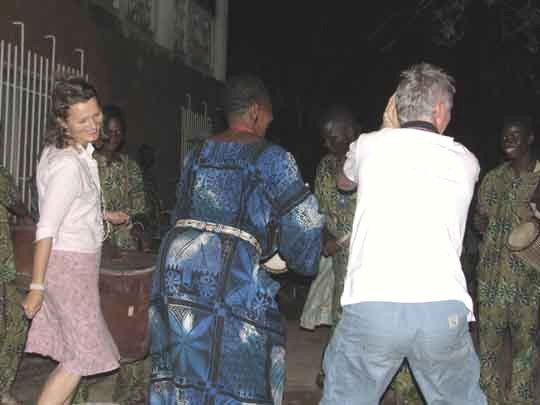
Back at the Nike Guest House we had an hour break before dinner. Our day did not end with drinks and food. Instead, we were entertained with cultural dance troupe performance after dinner. We were certainly amazed at how agile and acrobatic the dancers were. We were introduced to “Pasting” an act of appreciation for the performers during the dance performance by pasting money onto their heads. It was fun! Highlight was when we were invited to join in the dance. Some of our NFS members made an admirable attempt to mimic the rear-moving act of some dancers. Hilarious but nonetheless was well rewarded with pasting too!
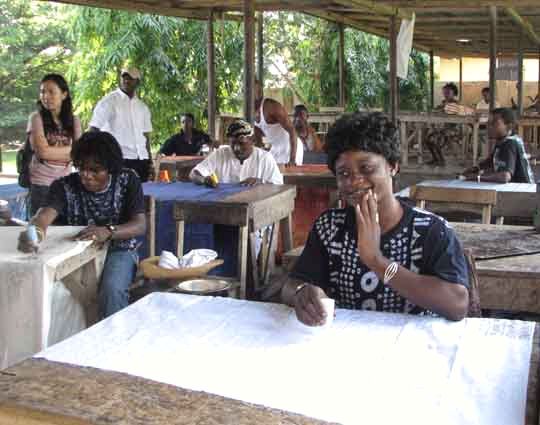
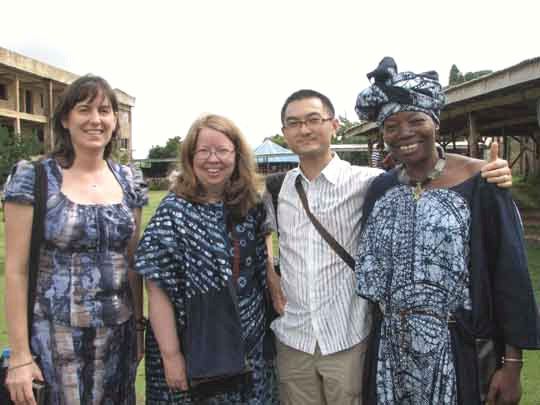
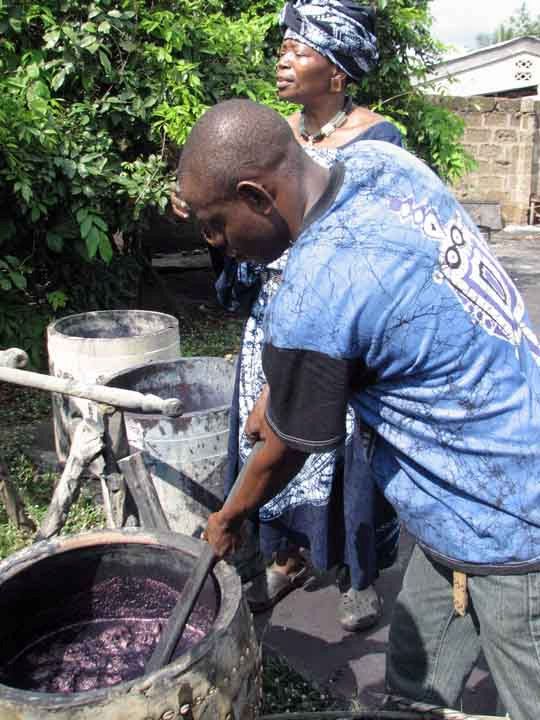
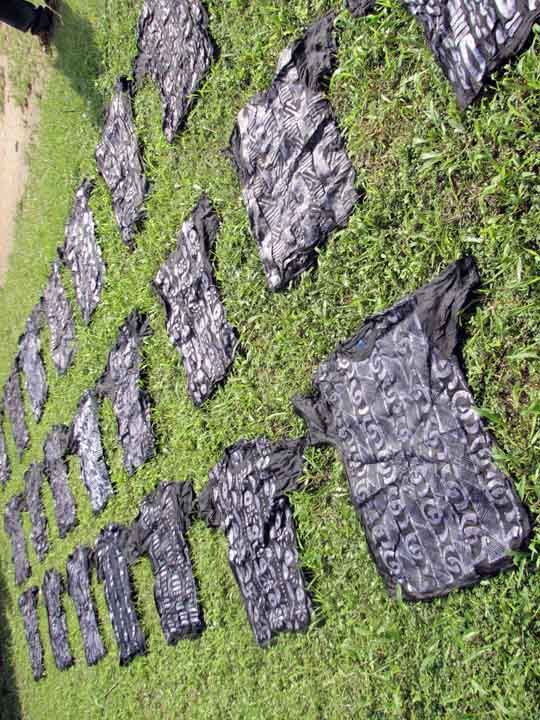
The next day started off with a wonderful English breakfast at the garden and by 9am we were whisked off to Nike Centre for Art and Culture. This place was opened in 1983 by Nike in order to create jobs for young Nigerians and encourage Nigerian women in the subject of arts. Nike explained that the Centre sometimes even feed and accommodate industrial trainee students free of charge, funded by the profits from the sale of items at the shop.
Here we saw contemporary Osogbo arts in painting, designs, batik, and metal and wood sculptures. Over at the workshop we were introduced to the traditional cloth making of Batik and Tie & Dye. It is commonly known as Adire – indigo dyed cloth produced by Yoruba women using a variety of resist dye techniques.
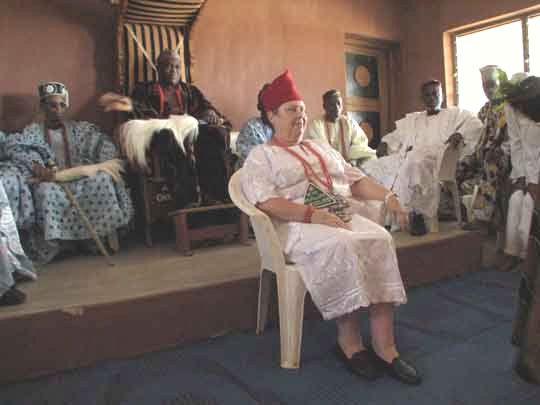
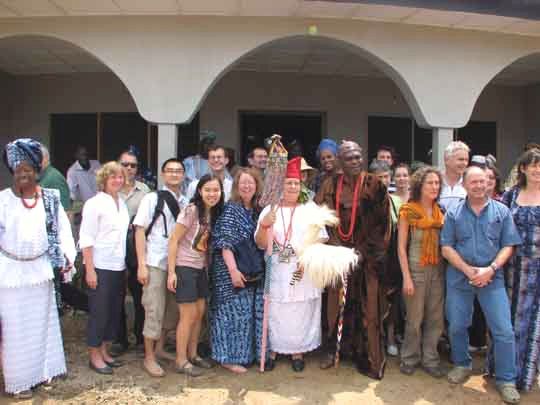
Our next stop was the palace of Oba Adeen, Oludo of Ido-Osun to witness the Chieftaincy ceremony of High Chief Paulette Van Trier. Chief Paulette was bestowed the highest title of Iyolade for her great contributions to the development of Osun. The ceremony started with a warm welcome by His Highness Oba Adeen that reaffirms Osogbo as a home to all of us from different parts of the world. The ceremony was short and full of boisterous music provided by the skilled drums men. Later Oba Adeen granted the Nigerian Field Society a private audience and even offered us an acre of free land each if we wish to build a home in Osogbo! I am not so sure about taking up his offer just now but perhaps will be kicking myself in a decade for not doing so when Osogbo is well developed!
The journey was quickly coming to an end by 1pm. We departed Osogbo after a quick lunch out at the garden again at N ike Guest House and got
back to Lagos after a 3-hour bus journey without much traffic jam. It was a tiring journey but I dare say has been one of the best weekend getaways in Nigeria by far made all the better by our wonderful Chief Paulette. Verdict on Osogbo – Highly recommended!
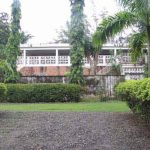
Welcome to the Ibadan branch of the Nigerian Field Society.
If you want to know what is happening in the Ibadan branch check this page.
We also have an archive of past trip reports for your information, you will find these here.
If you want to contact the Ibadan branch: [creativecontactform id=”1″] .
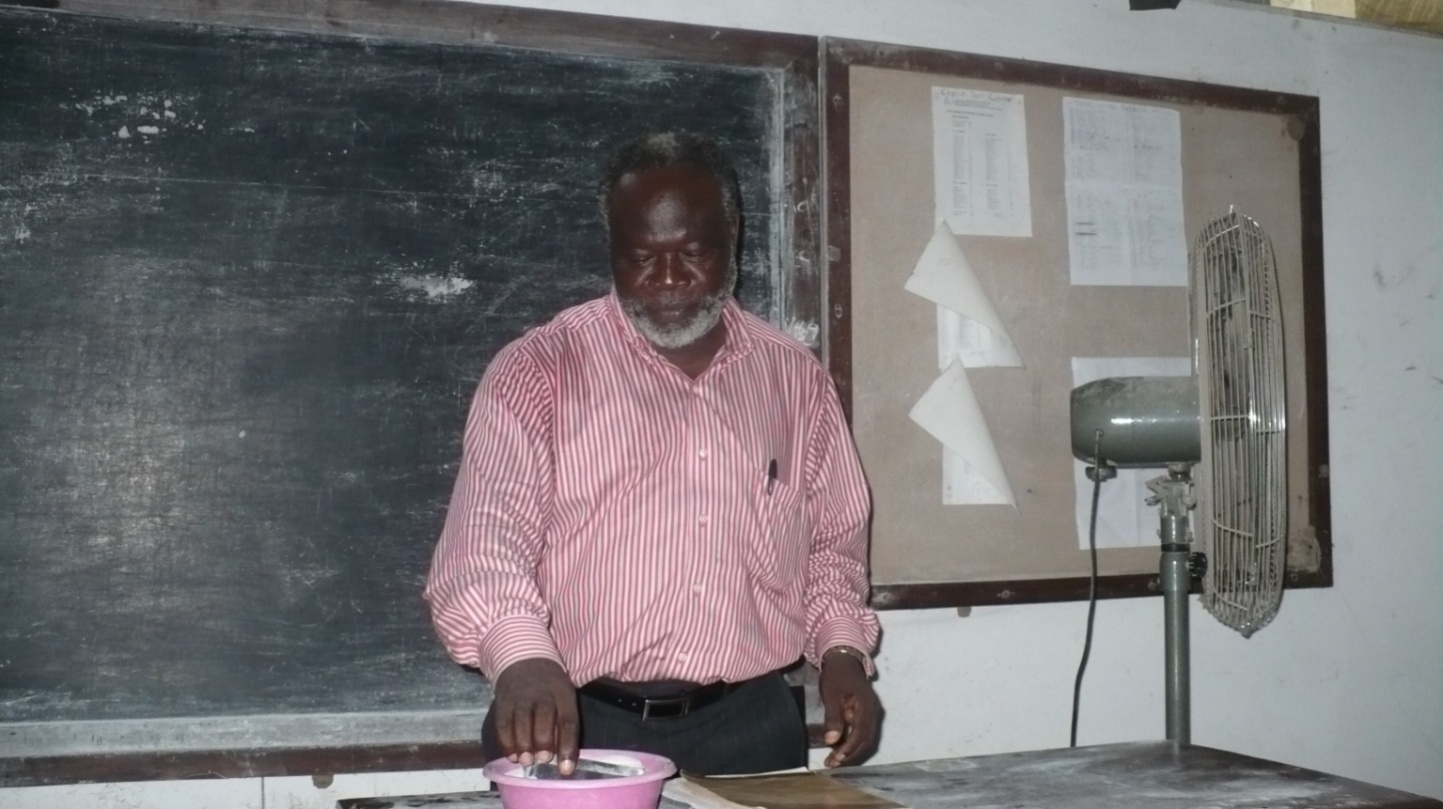
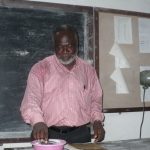
Forests in Nigeria
a summary guide
State
Despite the association of Nigeria with rich biological diversity and striking endemism, (“occurring only within a distinct area”) in its rainforest, the country’s terrestrial habitats are mainly savanna woodland and grassland. Montane vegetation grows on some elevations above 1 500m in the eastern margins of the country. Mambilla and Obudu hills are accessible examples. The southern forest belt is the hub of economic activity in Nigeria – oil wells, industrial establishments; large towns and villages interconnected with a network of roads, embedded in land with one of the highest population densities on the African continent.
140 million people growing at almost 3% per annum has consequences – all but 10% of the original forest estate is left in Nigeria! The resulting high ecological footprint is gradually spreading to the country’s northern borders. Progressive “sahelization of the savanna” and even stark desert encroachments are currently not rare. In southern Nigeria, the oil industry has shaved off swathes of rich mangrove forests in the Niger delta. Population drift to coastal cities, Lagos, Port Harcourt, Calabar, Warri, Yenagoa, Badagry impact moist forests that protect a low-lying Atlantic shoreline from storm surges and erosion.
Biodiversity
31% of the remaining forests in Nigeria are in Cross River State, which shares a boundary with Cameroon. The gene pool is impressive because this area survived the great ice age that affected the whole of central and West Africa many millions of years ago. There are more than 400 varieties of trees, around 170 species of reptiles and amphibians, 140 fish species in Cross River State. Of the 904 bird species recorded in Nigeria, 425 occur in Cross River. Endemic to these habitats and the adjacent Cameroon forests are the “Western mountain” gorilla, drills, and the redheaded rockfowl, Picathartes. Sclater’s monkey, the red-bellied and white-throated guenons are found only in Nigeria. Ibadan malimbe, Malimbus ibadanensis, a type of weaver bird is endemic to the forests of south-western Nigeria, around Ibadan in Oyo State.
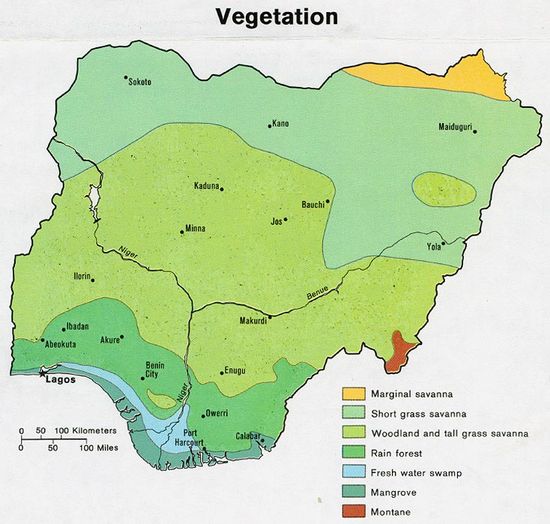
Forest uses
There are unhealthy demands on Nigerian forests for wood, food, fuels, industrial materials, medicines.
Threats
Unsustainable (largely illegal) logging, agricultural encroachment, over-harvesting of non-timber forest products, overgrazing of livestock in the savanna, infrastructure development, inadequate and ineffective legal frameworks for forest governance, poor research, insecurity of land tenure are the major threats. Will Nigerian forests in the near future be converted to production of feedstock for biofuels, i.e. into plantations to grow soybeans, cassava, sugar-cane, oil palm, nipa palm, maize, allanblackia, jatropha, etc.?
Climate change
Forests the world over are vast stores of carbon. Resulting from photosynthesis, there is more carbon stored in the trees of the world than in the atmosphere. In the process, tropical forests can absorb 10% of annual man-made greenhouse gas emissions. But destruction of these forests contributes over 17% of man-made emissions per annum, to cite a recent IPCC report.
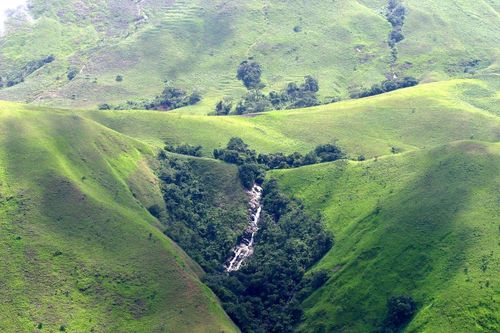
Solutions
Destruction of rainforests is an environmental problem that needs an economic solution. In order to out-compete the drivers of deforestation, carbon credits must be generated for forested states if they reduce vegetation loss to an agreed level each year. This can be monitored by satellite technology. The monies paid could then be channeled into engaging and training forestry personnel and park rangers, drafting of new forestry laws, agricultural intensification, renewable energy, education and small businesses, and building better roads and infrastructure in order to stimulate development and create alternative livelihoods.
Ako Amadi
Abuja, 24.March, 2010
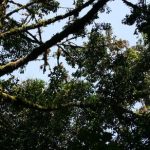
THE NIGERIAN FIELD SOCIETY (UK BRANCH)
Report for 2010
Chair: Professor Rob Oldham, Treasurer: Mr. Geoff Partridge, Secretary: Miss Sheila Everard
Membership of the UK Branch continues to flourish and although sadly, we have lost members through old age, we still recruit new people and attendance at meetings is strong in spite of the distance people have to travel.
AGM and Spring Meeting, Hatfield Herts. 24th/25th April 2010:
Twenty Three members attended the AGM held in the hall of St Ethelreda’s Church. The meeting was followed by a guided tour of the church which is dedicated to a 10th century Saxon princess. The church dates from medieval times and has strong connections with the Cecil family who have provided senior statesmen to the Nation from the 16th century. Our visit was followed by lunch in the cafe at Hatfield House and a tour of this magnificent establishment. Queen Elizabeth 1st first heard of her accession to the throne in the gardens of the old hall. The evening was spent convivially together at dinner in a local hostelry.
On Sunday members gathered at Gobion’s Wood, a nature reserve owing its existence to a group of enthusiasts who raised sufficient funds to purchase 222 acres of huge estate which was being sold for property development. The original group formed the Gobions Wood Trust and later gifted it to the Hertfordshire and Middlesex Wildlife Trust in order to preserve it for posterity. The rain eventually drove us all to Brookmans Park Hotel where Bernard Spatz gave us a talk on the history and development of this valuable local amenity. Many of our members are also involved in similar enterprise and a lively and informed discussion ensued. We are grateful to Eve and Peter Lloyd for organising the meeting.
Summer Meeting, Alnwick 19th/20th June 2010
Thirty members gathered in Alnwick Castle in June for a tour of this splendid, relatively new garden. Alnwick castle is second only to Windsor and has been occupied by the Percy family since 1309. In medieval times the castle was an important bulwark against Scottish invasion. In 1996 the present Duchess of Northumberland commissioned the Belgian Wirtz brothers to design the new garden and it has now reached maturity.
In the morning we split into two groups to watch the huge cascade, computer controlled, perform a variety of impressive spurts and patterned fountains beginning at the top and ending at the reservoir at the bottom where excited children race through the showers and collect water in little toy trucks provided by the establishment. The various features of the garden include a Serpent garden with polished steel sculptures creating curtains, whirlpools and towers of water. A bamboo maze, a rose garden, tantalisingly, just in bud as the cold weather had delayed flowering. I visited again, just two weeks later when all was in full bloom and the effect of both colour and scent was stunning. Above the fountain, a walled garden has a huge variety of plants and adjacent, is a poison garden where guides reveal and warn visitors of the dangers of plants which can be used for medicine or for more sinister purposes. An enormous tree house has a restaurant, video displays of the history and features of the garden and various walkways and swaying rope bridges in amongst the foliage.
The castle is a huge crenellated bastion. It features in the historical plays of Shakespeare as the home of Harry Hotspur and in more modern times, the setting for films (Harry Potter, Elizabeth, The Dark Knight) as well as hosting the Antiques Road Show. Our evening dinner at Blackmores in Bondgate without is just beyond the tiny medieval gate that until 1971, took all the main traffic north on the A1, before the bye pass was built.
On Sunday, a guided tour of the medieval town was followed by a visit to the huge Barter Bookshop situated on the old railway station where you may read in comfortable chairs by a huge fire; a model railway circulates the room overhead.
Autumn Meeting Bideford Devon, 10th/12th September 2010
In contrast, thirty one members travelled south to Devon where we were nearly all accommodated together in the Royal Hotel, Bideford. A coach was provided on Saturday morning to take us to Dartington Crystal Factory in Torrington. This venture was set up by the wealthy American owner of Dartington Hall in south Devon and her Yorkshire husband in order to provide work for this rather undeveloped area. We were lucky to find workers in, doing overtime to complete a Christmas order, so we had a good opportunity to see this intricate process in action. The working space is rather cramped but such is the harmony of the workers, they pass easily in and around one another, carrying rods of molten glass in smooth choreographed motion, not one drop spilt or one exposed limb burned.
From there the group were transported to the nearby Royal Horticultural Gardens at Rosemore. The garden was begun in 1988 after a gift by Lady Anne Berry of her 8 acre garden and an extra 32 acres from which the various RHS demonstration gardens have been developed. Numerous small gardens demonstrate various purposes and planting styles; at the lower end there is a superb ‘hot’ garden, with a stunning display of flowers and foliage in purples, reds and oranges. All was afire!
On Sunday most of the group met in Clovelly, a picturesque fishing village built in a gravity defying manner on a steep hillside leading down to the harbour by the sea. A new visitors’ centre welcomes visitors and a large car park is provided as there is no hope of driving anywhere near. The village streets are so steep that even today residents and tradesmen use sledges to pull their loads up and down the hill. Donkeys still ply one section, but now only for tourists. Our thanks are due to Anita and John Appleby for organising this varied and very interesting weekend.
Obituaries
We are sorry to announce the death of one member, Mr RG Mares in 2010.
Programme for 2011:
AGM and Spring meeting, Keswick, Cumbria 7th/8th May 2011, organiser Rachel Nicholson
Summer Meeting, Dungeness, Kent 11th/12th June 2011, organiser Steve Graham
Autumn Meeting, Montrose, Angus, Scotland 10th/11th September 2011 organiser Avril Simpson
The UK Branch welcomes Society members from other branches to its meetings. Anyone interested should consult the secretary (address on the front page).
Sheila Everard (secretary)
Meet our committee members
Ibinabo Oyibo (Co-Chair)
Lynsey Elston (Co-Chair)
Joan Egwuterai
Jaco Louw
Adun Okupe
Pelumi Fadairo
Jane Swiers
Robin and Hugh Campbell (past Co-Chairs)
Wil, Paulette and Filip Van Trier
Trip to: Niger Republic
Date: 16/9/06 – 25/9/06
Trip leader: Mike Newton
Trip report: Marita Buschendorf
Eight members (six ladies and two men) from the Nigerian Field Society, travelled from Lagos via Abuja to Kano. In Kano we were met by representatives from an Agadez based travel agency Takawat Voyages, the trip organisers. The travel agency team includes the tour guide Tanko, drivers and a cook. Our three 4×4 vehicles all looked old but serviceable and speed us off to the Prince Hotel.
After lunch at the hotel, we went to view the city of Kano, the old market and the dye pits where indigo-coloured fabrics can be purchased. While other members of the tour group were recovering at the hotel’s pool, Mike and Uschi buy supplies of water, fruit and provisions for the next day, our travel to Agadez.
Sunday, 17/9/06 At 7 a.m., we departed Kano and arrived the Nigerian – Nigerien border at 9.30 a.m. We were checked politely but very slowly by the immigration officials with lots of repetition of data recording (by hand) from desk to desk. We passed through the Nigerian border at 11.15 A.M but had to wait an equally long time in front of the immigration office in Niger. As we drive on the vegetation changes. In the flat countryside, we saw sugar cane and semolina being cultivated.
After about 90 km drive we got to the city of Zinder, where the water-tower, built by Chinese is very prominent. The vegetation was sparse after Zinder. We saw donkeys, goats and zebu cattle with their long horns and camels occasionally. The last stretch of the drive was on the new road still under construction. At 10 p.m. we arrived at the Hotel de la Paix in Agadez. Our guide recommended an excellent local restaurant, called Tamgak where we eat cheaply and well.
Monday, 18/9/06. We climbed the water tower at the hotel for panoramic views of Agadez, a vision of brown mud brick houses and the prominent mosque. Agadez is a caravan terminal which has been a focus for Trans – Saharan caravan routes for hundreds of years. Our next visit was with the money changers where after hard negotiations we achieve a rate of 1Euro to 650 Francs CEFA. The exchange agent doesn’t deal in Naira.
Our departure was one and a half hours late as one of the cars was being fixed. We finally left the hotel at 12.20 p.m. but were compelled to drive back to a workshop soon after our take – off due to a broken shock absorber on the third car. Our cook, Mohammed pampered us with fresh vegetable salad, mini sausages, French baguette and bananas.
After lunch we headed for In-Gal and it’s Gerwol Festival, known as the Festival of Beauty. We arrived at 5 p.m. finding the festival in full swing. We met the Wodabee, who are thin graceful people who spend there whole lives wondering the desert and make up about 10% of Niger’s population. The young, very slim men have made up their faces with yellow colour with dark outlines to their lips and eyes. The men wear long robes, lots of jewellery and carry swords. They dance while rolling their eyes and smiling while the girls watch silently with occasional giggles. Just like a high school dance. The men dance in long lines and sing to the monotonous music which is stimulating us to dance, too. We listened to the music for the whole night as we slept under a sky full of stars. Sitting in a circle around the camp, a pack of wild dogs sang the whole night as well.
Tuesday, 19/9/06. We drove back to Agadez passing nomads returning from the festival and Faluni tribal men tending there goats. We then travelled north to Dabous. We drove past a petrified forest of tree trunks. This region is sparsely populated; neverthless the speed limit is 50 km/h. Our travel leads us to the famous 11,000 year old Dabous rock art. The centre piece is two giraffes but on the surrounding rock we find more savannah animals. All carved at a time when this desert was savannah grassland. There are a lot of tourists in December, but now in September we are alone.
We continued on a stony terrain in the direction of the Air Mountains. In a valley there was lush grass with many nomad encampments, but as we climb higher we found dark volcanic rock. Even here there are trucks full of people returning from working in Algeria. Again we spent the night under a clear, most impressing starry sky. This time we were guest to many flies and mosquitos.
Wednesday, 20/9/06 Already by 7.45 am we are up and driving northeast to Iferquane. The track leads over sand and lava. Grass and brushwood grow sparsely. Far away in the haze we could spot the dark grey peaks of the Air Mountains. Again we had technical problems with two vehicles, one a puncture that was quickly fixed but the other car had a leaking radiator. We took advantage of the long stay in Iferquane to buy some silver jewellery that the Tuareg are famous for. The bird life is prolific. Our cook serves lunch in a private compound. Three hours later, one of the cars got stuck in soft sand and was dug out using sand ladders. That night we camp surrounded by large dunes. We had a very quiet night with no mosquitoes. We were captivated by the shadows created by the suns rays on the dunes and the knife edge arêtes. We were up early watching the sun rise. On the top of the dunes we follow beetle tracks. There is life up here!
Thursday, 21/9/06 We head off towards Kogo and speed across hard sand at 90 kmh with great views of the Air Mountains. We scare a small deer which runs off at speed. At a waterhole, we meet some nomads where and bought some pottery and jewellery. A French couple are carrying their water in a goat skin tied to the outside of there vehicle. Evaporation from the surface of the goat skin keeps the water cool in side. Our water containers are filled and some of us use the opportunity to wash our hair. Later we find exposed slabs of white marble lying in the desert.
We meet another group of nomads. The children don’t laugh as usual and they are not curious. All of them suffer from running stools. A small child has ear ache. We help out with some ears drops, herbal tea and milk powder. The crucial problem is the dirty drinking water.
We arrive at a tiny village and take the opportunity of riding on camels while the hordes of children observe with interest. Afterwards we drove until we reached the edge of the Tenere Desert. Again we saw rock art. For the night we camped in a dried river bed.
Friday, 22/9/06 We drove from Kogo to Assode, a town in ruins. This is the oldest settlement of the Touareg, with a very large cemetery. A stone marks each persons head and feet. The vegetation is sparse; we saw the Euphorbia bush with its prominent leaves which are traditionally used for healing wounds. We drove through several Touareg settlements and visited a small water well (whose walls are collapsing) but is used for irrigation of a patch of land in the dry landscape where grape and vegetable is grown. As we continued up the mountains, we saw nothing but rock and stones, the temperature also remained hot, 41 degrees C in the car.
Finally we reached a valley and the Timia oasis. Timia is like a big market garden. The people live in small yellow mud houses, that all look the same. They grow tangerines; oranges, grapefruit, limes, grapes and, pomegranates, dates and vegetables. It is from here that the Camel trains used to leave for Bilma to trade for salt. We are allowed to pick fruit from the trees, and eat our fill and go away loaded up for the journey.
We had lunch by the cascades of Timia. A stream rushes down the black volcanic rock into a large pool. Most of us swim in the main pool and climbed up into the two higher pools. This was a refreshing experience after the dryness of the desert. The local boys stare at the ladies wearing bikinis.
Again our travel is interrupted by a vehicle breakdown near Kreb-Kreb. We took a walk while temporary repairs are being carried out. This night will be the last one under the ‘heavens’. As usual our cook prepared a meal over the open fire. Lindie again kept us amused by suggesting a new game. We camped once more in a dried river. Afterwards as on every other night we all retreat to our own spot about 30 foot from the fire and lay down on foam mattresses. One could sleep under the stars every night.
Saturday, 23/9/07 We had to get up very early. We drove on a volcanic rock plateau and through several villages back to Agadez. There are wells in the villages to water the plantations. The rivers were dry. We stopped in one village for the Saturday market and tried fast food, strips of goat meat, liver and kidney sprinkled with cumin.
We arrived at Hotel de la Paix by noon. Having taken a shower, we had lunch at the Travel Agencies offices and caught up with Ousame the Agency Director. Our cook Mohammed had again excelled, the meal tastes marvellous.
In the afternoon we visited the main mosque and the minaret. This is of classical mud construction in the Sudanese style, about 27 m tall. We climbed up the tower in the dark and touched sleeping bats. With our party of 10 on the top we could feel the tower move. The planks of wood on the outside allow for workers to stand and re-apply the mud. Again we had dinner in the Tamgak restaurant near the hotel.
Sunday, 24/9/07 At 5.30 a.m. we started our journey back to the Nigerian – Nigerien border and to Kano. We noticed the spread of the Sahara desert as it continues to spread to the south and south west.
There were few vehicles on the road; some were very heavily overloaded trailers, full of people and goods. The Lorries were twice as wide as the vehicle width with everything tied on to the sides. These trucks are on the way to Algeria, taking people to work and will travel right across the desert. One of the trucks had broken down. The heat is strenuous, 40 deg C or more at noon. Uschi keeps us all supplied with fruit and sweets, her camera broke early on the trip but we promised her all of our photographs. Uschi will leave Nigeria next year after 30 years, we will all miss her.
After a 14 hours drive we arrived at the Prince Hotel in Kano. The border took us only one and a half hours to cross this time.
Monday, 25/9/07 Gratefully we said good-bye to our drivers and to our guide Tanko. We flew back to Lagos. This was a fantastic journeywith lasting impressions, like all journeys’ it has come to an end.
Trip participants
Mike Newton (Trip Leader) , Lindie Rudover, Uschi Boersing, Virag Gal, Arend DeRroo, Akkie de DeRoo, Vivian Neglai, Maria Buschendorf.
Below you will find a list of past trip reports of the NFS Abuja branch in alphabetical order:
The Nigerian Field 65:3-11 (2000)
THE NIGERIAN FIELD SOCIETY THEN AND NOW
David T. Okpako
Vice-President & Chairman of Council, 1992-1994
President & Chairman of Council, 1994-2000
How it began
At the ripe age of three score and ten years, the Nigerian Field Society (NFS) is entitled to reflect on its life. From the minutes and other documents of the Society one gets some impression of the great events that shaped it from the beginning. As Chairman of Council, I have had the privilege to see the Society at work at close range for the past eight years. I consider it a great honour to be able,in that capacity, to write this tribute, which consists mostly of snippets from the records seen in the light of present day.
Founded in 1930, only 16 years after the amalgamation of the Northern and Southern protectorates and 32years after Flora Lugard (née Shaw) first gave the name Nigeria to the several British protectorates on the Niger, but 30 years before Nigeria became independent, the NFS’ struggles for survival have paralleled those of the nation whose name it bears. The NFS founder himself, Mr. A.F.B. Bridges, B.E.M. (1895-1994) was born in another colonial territory, India, just before the Berlin Treaty of 1898 where European colonial powers carved up Africa and assigned the territory now known as Nigeria to Queen Victoria’s Britain.
Frank grew up at a time when the British colonial administration was consolidating its hold on its African territories. He arrived in Nigeria in 1921, aged 25, to take up the post of Assistant District Officer (ADO) at Onitsha. To get there from Port Harcourt where his boat landed, he had to trek for 14 days through the bush. Frank has described his experience of this journey (the company of trekkers included 3 Europeans and 116 local carriers) in his autobiography titled, How we used to do. In it are some memorable descriptions of spectacular scenery of the tropical rain forest as it was then. Here is an example from page 3:
The footpath pushed its way rudely between groups of immense trees standing together as if in conversation, their 80-foot trunks free of all branches below the level of the canopy,the silence only broken by the laughing cackles of hornbills and the swish of their wings as they flew about, high up above the branches.
There are hardly any high forest trees “standing together in conversation” any more anywhere in Nigeria. Almost certainly, it was his experience of treks in the tropical bush that stimulated Frank Bridges into thinking of founding a journal similar to The Field (then published in London), in which observations of an outdoor life in Nigeria would be recorded. According to his own notes (see Minute Book, vol. 1, p. 1), the thought of a Nigerian Field Society and a journal had occurred to him very soon after arriving in Nigeria. But it was some time before the first meeting of the Society was held in Enugu, on 3 October 1930. The Nigerian Field was started the following year, the first issue appearing in 1931, 10 years after Frank Bridges’ arrival in Nigeria.
How NFS used to do
Some reflection on the Society’s 70-year experience is important in order to appreciate properly the present and anticipate the future. The Society has been more or less faithful to the founders’ aims which appear in different wordings in our documents. The substance of the aims remains as it was first stated on 18 March 1931 (Minute Book, Vol. 1, p. 16):
A Society has been formed… with the object of encouraging interest in Nigeria, its fauna and flora, its history, legends and customs, its native arts and crafts, and science, sport and hobbies. It is a non-political, non-sectarian Society, and open to all Nigerians, past and present, European and African. (my italics)
The phrase “all Nigerians past and present” may seem obscure but it was most probably a reference to the tendency of the colonial servants and other Brits then to see themselves as “Nigerians”, and even “Southern” or “Northern Nigerians” depending on where they served. This attitude underlines the great enthusiasm that one finds today among former Nigerian colonial civil servants, former academics, school teachers, missionaries and others who now constitute the backbone of the Nigerian Field Society in the UK. The direct mention of “African” as a category was to emphasise, I suspect, that in this Society, unlike many European Clubs then, no racial bar would operate. However, the issue of the classes of membership and their privileges repeatedly cropped up at early meetings of the Society. For example, a meeting of Ibadan members of the Society held on 22 May 1936, presided over by a Major L.R.C. Sumner, unanimously accepted the Honorary Secretary’s proposal for three classes of membership, namely Fellows (paying £1 per annum subscription), members (10 shillings) and junior members (Africans only, 5 shillings). Junior members were not to have a vote; it is doubtful if there was any significant number of African members of any class in the Society for many years. This would not be surprising; the curiosity that drove Europeans to take a keen interest in the Nigerian environment was probably matched on the part of Nigerians by equal wonder that “these funny Europeans” could show so much interest in ordinary butterflies, poisonous snakes, simple flowers etc. Nigerians then, not unlike people elsewhere, took their environment for granted. It is interesting to note that many senior Nigerian members of the Society today are in the same age grade as the Society and have lived through the same changes in environment and fortune.
Mother of NGOs
It must be stated that the NFS’s position as the “mother” of non-governmental organisations in Nigeria is unquestionable. Although the Society was founded simply “with the object of encouraging interest in Nigeria… etc.”, the Society nevertheless played the part of a pressure group for action on the environmentand conservation right from the beginning. (1) At a meeting of NFS held in Enugu on 11 August 1937, members agreed to write letters to Government urging steps to preserve wild life and develop game and forest reserves in various parts of Southern Nigeria—Anambra Reserve in Onitsha Province, Gilli-gilli Reserve in Benin Province, Olokemeji Forest Reserve in Abeokuta Province etc. These ideas were latertaken up at meetings of members in Calabar, Enugu and Ibadan; at one point it was suggested that the Carnegie corporation be approached for a grant to build a museum! At the same meeting in Enugu in 1937,the idea of a permanent headquarters building for the NFS was mooted, but nothing came of it and the proposal was later dropped (on this more later). It is humbling to know that there is little that we have included in the agenda of Annual Business Meetings or Council in recent years that the NFS has not already considered in its 70 years of life; in its old baggage are many “unfulfilled” ideas which the Society has taken in its stride. Quite often what hindered the actualisation of some NFS ideas was what might seem to be the Society’s own anmbivalent attitude to “progress”. In 1971, Frank Bridges, writing a proposal for a permanent headquarters building for NFS, in his introduction to the special 40th anniversary issue of The Nigerian Field, said:
We have depended entirely on the subscription of members, the constancy of their support and the fact that no payment of any kind has ever been made to officers or contributors. Outgoings in the form of rent and paid staff have been eliminated by the fact that the only headquarters the Society has had have been the homes of its officers. The affair has been throughout a labour of love.
So, while the idea of a permanent headquarters repeatedly came up in the agenda of NFS meetings, its implementation was never pursued with vigour, probably because the leaders appreciated the value of the Society having its headquarters “in the homes of its members”. During the last eight years since I have been privileged to be Chairman of Council of the NFS, two matters have been on the agenda: befitting central accommodation, and the registration of the Society as a charity. Although the present Council has tried to move both issues as far forward as possible, we can claim spectacular achievements on neither front. The one-room accommodation made available to us free of charge by Mr. A.P.Leventis at the A.G. Leventis Compound in Moniya and which now houses back issues of The Nigerian Field and other important NFS papers, can indeed be described as a “Member’s Home”, for Chief Leventis is a long standing member of the Society. I may say here that as we continue to accumulate Society material, the Moniya facility willsoon become inadequate as well as being inaccessible to members and other users of our stock for research purposes, so we need a bigger and more central facility, which we have not yet been able to secure.
Slow progress on both these fronts (accommodation and registration) may be said to be due to this particular Council’s inertia, but equally likely is the collective conservatism in the body of the membership. What will registration of the Society really mean? Why do we need do we need to register the Society, when we have done well without doing so up till now? And, will registration and high profile accommodation not expose us to interference from Government and politics and rob us of traditional independence? Despite assurances from lawyers to the contrary, these concerns persist in the minds of some of our committed members. My own gut feeling is that members are justified in harbouring these reservations; the turn-over rate of high profile institutions in Nigeria is notoriously high. Big budgets are a source of great temptation and societies and journals launched with great fanfare often do not last for more than a few years. Therefore the NFS’s concern that we should only undertake improvements which we can manage successfully is understandable and largely justified. New generations of younger managers of our affairs ought to bear this in mind as the Society settles into grand old age.
Transition Our family historian, my wife, has informed me that we became members of the Nigerian Field Society in 1973. Kath has always liked the idea of a society in which each member is committed to doing something (even at some cost to him/herself) for the common good — a true Lloyd George Welsh trait! She has served the Society in various capacities with enthusiasm and her support for the Society and me remains undiminished. Most of my participation from that date consisted in accompanying her to meetings and events. I enjoyed these outings. It was later, on one such outing, that I first met Chief A.M. Oseni, OFR, FAS, of blessed memory, of whom I had already heard a great deal. Tony, as his friends called him, was a man of great charisma and charm. His reputation as the “first Nigerian this and first Nigerian that” (including being the first Nigerian Chairman of Council of the NFS), and as a major force behind the push for the Society’s management to be located in Nigeria, was already well established. He led easily;everything was done with humour.
Following Chief Oseni’s regretted death, I was invited to become Chairman of Council in 1992, and two years later following the death of the founder, Frank Bridges at the ripe old age of nearly 99, I was elected President in 1994 at the Ile-Ife ABM. I have been very worried ever since! One cannot ask for a greater honour than to have the confidence of an organisation of the complexity and history of the NFS. The NFS is a unique club; the most important decisions are reached by consultation and consensus. Presumably, with my wife by me, I was an ideal transition between the old and the new Nigerian Field Society. Be that as it may, I have enjoyed the excitement of managing the transition.
A word about our journal The Nigerian Field
Our journal, The Nigerian Field, has from the beginning been the main visible record of the Society’s activities, and remains so till today. It is on the Journal that the external reputation of the Society rests, but its successful existence depends on the constant support of members of the Society and the selfless dedication of its successive editors (it is remarkable that there have only been five editors since its foundation in 1931). Frank Bridges and the founding members made publication of the Journal, the Society’s priority, knowing that observation of the environment without field notes was of no value to posterity. Thus, through heroic efforts, the journal was printed more or less regularly throughout the Second World War and the Biafran/Nigerian Civil War. When the time came to transfer the management of the Society of Nigeria (of which Dr. Ronald Keay, CBE, and Chief Tony Oseni, OFR, were strong advocates) some members, Mr. E.F.G. Haig (editor for 42 years!) in particular, were reluctant to surrender the Journal’s publication to the “Resident Committee” in Nigeria for fear that the customary high standard of production and regularity would be compromised. Mr. Haig actually wrote what was considered by many to be a controversial letter to the University of Ibadan, urging the latter to take over the Society and its Journal! The correspondence on this potentially explosive matter between the Secretary of the Resident Committee in Ibadan, Mrs. Jen Maddison, and the Branches makes very interesting reading in the Journal and in the minutes. Fortunately, the Society retained its independence in the end, and since 1975 the Journal has been produced successfully in Ibadan.
The Nigerian Field is arguably the most important single source of scientifically recorded field observations on West Africa since 1931. The range of coverage is extensive—from fauna and flora to culture and traditional medicine. Nigerians of various disciplines have become active in contributing to the Journal and articles in the areas of culture, history and art now constitute a significant proportion of Journal articles. The Journal represents a priceless collection and is one reason why the growth of the Society must be sustained, and every effort made to ensure the security of back numbers.
How we are doing now
The election of President and Chairman of Council of NFS in 1994, some might say, was an historic event, being the first such election. We can say that since then, we have been undergoing further transition. In this period, Council’s guiding principle has been consolidation of the gains made in the past 70 years and conservation of the resources of the NFS. We have had our Council Minutes and other important papers restored and bound (Society is grateful to the LJK Branch for its cash donation for this work); we have revised The Rules, to bring them into line with present realities; we have had modest increases in membership; new branches have come into existence (although some old Branches have also become moribund); we have kept all Branches in touch with the Society, including the UK Branch, and we have had an Annual Business Meeting every year since 1992. In other words, we have tried to stabilise the operational basis of the Society. If there is modest success in that respect, it has been due largely to those who actually do the work of Council—the Honorary Secretary, Treasurer, Editor, the Vice-Presidents — and the Branches and their activities. I have been very fortunate to have worked with such a dedicated group of members in the last eight years.
The environment in which the NFS operates today in Nigeria is quite different from what it was in its early years. Since those in authority in Nigeria failed to heed the advice NFS offered repeatedly over the years, the Society now finds itself in the regrettable position of being able to say to Government, “I told you so”; the forests and wildlife are virtually all gone. Meanwhile, following world media apocalyptic predictions of the effects of global warming, the imminent extinction of our biodiversity and our planet, there is now a plethora of non-governmental organisations (NGOs) in Nigeria. This now places the burden on the mother of NGOs in Nigeria to redefine her relevance in the present circumstances. In spite of our members’ collective tendency to resist change, changes in this direction will have to be made, however cautiously if only to make the wealth of 70 years accumulated wisdom and resources available to the community of NGOs in Nigeria. I can see the NFS outliving most of the new NGOs in the next 70 years. I can see the NFS becoming recognised as an independent authoritative source of information on culture and the environment in Nigeria. There is no reason why, by the end of the next 70 years, the Society should not boast of its own modest headquarters with a small number of paid staff, perhaps a secretary, a gateman, a librarian, and maybe a twenty-first century communication device, a computer, to streamline communication between Branches. I say in the next 70 years realistically, but perhaps the next Council of the NFS will surprise me by making this happen in my lifetime!
1. Editor’s note: The Society was equally concerned about the preservation of artifacts through museums (Niger. Fd. 62:55).
Trip to: Omo forrest
Date: Jan. 2006
It took one very long, cratered, claycoloured road to get us there, but 20 NFSers made the journey to Ogun State’s forest reserve, Omo Forest, in January to find a rare treasure in Nigeria – backwoods camping!
The Omo Forest campsite is just off the dirt road that carves through the reserve and joins a handful of human settlements in and around the area. According to one web site, Nigeria and West African Bush, Omo Forest Reserve is located about 135km northeast of Lagos, some 20km from the coast. The terrain is undulating and elevation reaches about 300m on some rocky hills. The eastern boundary is formed by the Omo River, which with its many tributaries, drain the reserve. Omo is contiguous with five other, highly degraded forest reserves, the largest of which is Oluwa Forest Reserve to the east. The vegetation is mixed moist semievergreen
rainforest and due to selective exploitation in the past, the forest is largely mature secondary.
Specific accolades should be made to Steve, Lindie, Sharon and Jonathan for biking the final 12km distance that most of us enjoyed from the comfort of our SUVs. With heat waves shimmering off the hoods of the cars, we thought we were the smart ones to stay airconditioned cool, that is, until we arrived at the bridge. Forget the snakes and sundry carnivorous insects that one might imagine were waiting to ravage us in Omo forest. Our first and largest challenge would be to cross the passage over Omo river by navigating our vehicles across unfastened slabs of timber – one of which got jammed into the bottom of our police escort’s pickup!
Our twowheeled friends, however, breezed over the bridge and even got to the site before most of the rest of us – goes to show who the smarter ones were in the end.
The campsite is a large clearing speckled with a few sleeping cabins, one covered mess area, a kitchen (to be read: a room with a bucket!), and an outhouse and camping shower that the bikers were quite grateful for. After pitching our tents and dropping a couple of loads, the group set off again for a forest trek led by Titus, our local guide.
Here, a large path gave way to a narrower one, which gave way to a trail covered by lowlying shrubs and then gradually waistlevel bushes until we were bushwhacking through the woods in search of the fabled forest elephant. Our only signs that they actually exist were the few piles of dung we encountered along the way, but the lack of pachyderms was made up for by dozens of different bird sightings! 147 species have been recorded in Omo and even our resident expert John Barker was occasionally at a loss to name them all.
Our journey, which included a brief but steep summit up one of the forest’s plateaus, was rewarded by a beautiful view of Omo valley shrouded in an unusual afternoon fog. For this Canadian, the sight of red and yellowleafed trees amongst the green was nostalgic of an Ontario autumn.
The evening itinerary included a neargourmet meal hosted by John and a night trek through the forest to see the bush babies – a yelloweyed nocturnal animal that looks like a hybrid between a monkey, bat and rat and is indigenous to the African bush. The next morning we set off for the woods again to be impressed by the awesome tree trunks and root networks that give Omo forest its charm. While they stayed hidden, monkeys calling to one another throughout our hike provided an interesting soundtrack to the trip!
Short but sweet, our visit was a nice retreat from the urban jungle of Lagos!